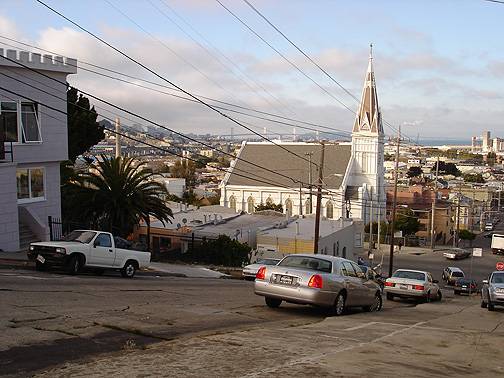Hunters Point Mid-1990s: Difference between revisions
m (1 revision(s)) |
(added link) |
||
| (12 intermediate revisions by 2 users not shown) | |||
| Line 1: | Line 1: | ||
'''<font face = arial light> <font color = maroon> <font size = 3>Unfinished History</font></font> </font>''' | |||
[[Image:Bayview-church1212.jpg]] | |||
'''Old church on Phelps and Palou Ave, just north of Silver Terrace in Bayview.''' | |||
''Photo: Chris Carlsson'' | |||
In | ''"In the southeastern neighborhood of Hunters Point, neighbors organized in the Morgan Hill Resident Association are combatting a plan to build a third power plant in the area (PG&E already has two coal-fired plants along the bayshore nearby). Charges of environmental racism have beset the proposal, since the Bayview/Hunter's Point neighborhood, a largely African-American neighborhood, is already home to several dozen known toxic sites, many residents complain of respiratory problems and strange cancers, and no one is proposing placing power plants in other neighborhoods in San Francisco. Supervisor Terence Hallinan stated in a public hearing that of the five major sources of acid rain in the Bay Area, 'two are in Bayview/Hunter's Point.'"'' (''S.F. Chronicle ''2/13/95) | ||
' | The [[Hunter's Point Naval Shipyard|Hunters Point Naval Shipyard]], due for decommissioning, has undergone a year-long community process of planning for its reclamation and re-use. The latest tenant to move in and try to save its historic use as a shipyard is Astoria Metals, which is planning to rebuild old battleships into floating power plants for use in underdeveloped countries. The plan, costing $20 million, will take three years, and gives city planners and neighborhood activists hope that the maritime use of the historic 550-acre site can be preserved. Astoria's tenancy was ended under a cloud, with numerous charges of toxic discharge violations pending. The military's toxic residue, however, will take until 2007 to completely decontaminate. | ||
[[ | In May, 1995, a controversy erupted over conflicting plans for 30 acres atop [[Bayview Hill|Bayview Hill]], which looms over Candlestick. The land's owner, a Bayview native who inherited the land from her deceased husband, wants to build housing on her land, but the Recreation and Park Department has designated the land for acquisition under San Francisco's Open Space development program. It is expected that the land will be purchased through negotiation or eminent domain and will become a new park for the area (though in fact it has remained open and undeveloped all along). | ||
''--Chris Carlsson, 1996'' | |||
2011: Bayview Hill is a treasured local park now. | |||
[[Removal of the Butchers | Prev. Document]] [[Chinese shrimping village| Next Document]] | |||
[[ | [[category:Bayview/Hunter's Point]] [[category:Ecology]] [[category:Water]] [[category:1930s]] [[category:African-American]] [[category:1990s]] | ||
Latest revision as of 12:19, 24 July 2011
Unfinished History
Old church on Phelps and Palou Ave, just north of Silver Terrace in Bayview.
Photo: Chris Carlsson
"In the southeastern neighborhood of Hunters Point, neighbors organized in the Morgan Hill Resident Association are combatting a plan to build a third power plant in the area (PG&E already has two coal-fired plants along the bayshore nearby). Charges of environmental racism have beset the proposal, since the Bayview/Hunter's Point neighborhood, a largely African-American neighborhood, is already home to several dozen known toxic sites, many residents complain of respiratory problems and strange cancers, and no one is proposing placing power plants in other neighborhoods in San Francisco. Supervisor Terence Hallinan stated in a public hearing that of the five major sources of acid rain in the Bay Area, 'two are in Bayview/Hunter's Point.'" (S.F. Chronicle 2/13/95)
The Hunters Point Naval Shipyard, due for decommissioning, has undergone a year-long community process of planning for its reclamation and re-use. The latest tenant to move in and try to save its historic use as a shipyard is Astoria Metals, which is planning to rebuild old battleships into floating power plants for use in underdeveloped countries. The plan, costing $20 million, will take three years, and gives city planners and neighborhood activists hope that the maritime use of the historic 550-acre site can be preserved. Astoria's tenancy was ended under a cloud, with numerous charges of toxic discharge violations pending. The military's toxic residue, however, will take until 2007 to completely decontaminate.
In May, 1995, a controversy erupted over conflicting plans for 30 acres atop Bayview Hill, which looms over Candlestick. The land's owner, a Bayview native who inherited the land from her deceased husband, wants to build housing on her land, but the Recreation and Park Department has designated the land for acquisition under San Francisco's Open Space development program. It is expected that the land will be purchased through negotiation or eminent domain and will become a new park for the area (though in fact it has remained open and undeveloped all along).
--Chris Carlsson, 1996
2011: Bayview Hill is a treasured local park now.

